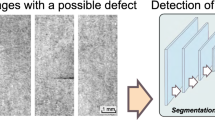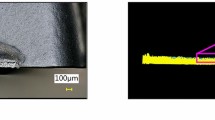Abstract
Detection and quantification of defects from metal and metal-coated surfaces is one of the main challenges in computer vision-based semantic segmentation. Manual inspection is not a practically feasible solution for identifying defects such as surface-level cracks, scratches, and manufacturing mistakes, especially when we have to deal with large number of test subjects. The metal defects can be of different size, shape, and texture and often show close resemblance to the possible artefacts due to normal wear and tear and brush markings of metal coating. Hence it will be quite challenging to come up with an efficient segmentation method for quantifying such defects. In this work, we propose an automatic segmentation and quantification approach for inspecting defects from digital images of titanium-coated metal surfaces with a customized Deep learning architecture: UNet. The scheme uses a supervised learning approach with convolutional neural network (CNN) and can learn the suitable representations and features from the training data without any handcrafted features or human intervention. The proposed image segmentation method also uses appropriate pre-processing and post-processing stages. The input images are filtered using median filter for eliminating possible impulse noises, and the output mask generated from the CNN model is post-processed using suitable morphological operations for eliminating false detections. The detection and segmentation performance is evaluated using standard benchmarks, and the overall Dice score of the proposed model is 91.67% with a precision of 93.46%.





Similar content being viewed by others
Change history
01 June 2022
This article has been retracted. Please see the Retraction Notice for more detail: https://doi.org/10.1007/s12652-022-04018-1
References
Adhikari RS, Moselhi O, Bagchi A (2014) Image-based retrieval of concrete crack properties for bridge inspection. Autom Constr 39:180–194
Ahamad NS, Rao JB (2016) Analysis and detection of surface defects in ceramic tile using image processing techniques. Microelectronics Electromagnetics and Telecommunications. Springer, New Delhi, pp 575–582
Aslam Y, Santhi N, Ramasamy N, Ramar K (2018) An effective surface defect detection method using adaptive thresholding fused with PSO algorithm. Int J Simul Syst Sci Technol 19(6):1–7
Aslam Y, Santhi N, Ramasamy N, Ramar K (2019) A modified adaptive thresholding method using cuckoo search algorithm for detecting surface defects. Int J Adv Comput Sci Appl 10(5):214–220
Brownrigg DR (1984) The weighted median filter. Commun ACM 27(8):807–818
Chen CH (2015) Handbook of pattern recognition and computer vision. World Scientific, Singapore, pp 1–483
Chuang KS, Tzeng HL, Chen S, Wu J, Chen TJ (2006) Fuzzy c-means clustering with spatial information for image segmentation. Comput Med Imaging Graph 30(1):9–15
Cremers D, Rousson M, Deriche R (2007) A review of statistical approaches to level set segmentation: integrating color, texture, motion and shape. Int J Comput Vis 72(2):195–215
Deng Y, Manjunath BS (2001) Unsupervised segmentation of color-texture regions in images and video. IEEE Trans Pattern Anal Mach Intell 23(8):800–810
Duygulu P, Barnard K, de Freitas JF, Forsyth DA (2002) Object recognition as machine translation: learning a lexicon for a fixed image vocabulary. In: European conference on computer vision, pp. 97–112
Forsyth DA, Ponce J (2002) Computer vision: a modern approach. Prentice Hall, Upper Saddle River, pp 1–720
Gandomi AH, Yang XS, Alavi AH (2013) Cuckoo search algorithm: a metaheuristic approach to solve structural optimization problems. Eng Comput 29(1):17–35
Garcia-Garcia A, Orts-Escolano S, Oprea S, Villena-Martinez V, Martinez-Gonzalez P, Garcia-Rodriguez J (2018) A survey on deep learning techniques for image and video semantic segmentation. Appl Soft Comput 70:41–65
Ghahramani Z (2015) Probabilistic machine learning and artificial intelligence. Nature 521(7553):452–459
Janocha K, Czarnecki WM (2017) On loss functions for deep neural networks in classification, pp. 1–10
Kalaiarasi M, Indolia Y, Seema N, Kumar B (2019) Metal crack detection using image processing. Int Res J Eng Technol (IRJET) 6(6):930–934
Khan MW (2014) A survey: image segmentation techniques. Int J Futur Comput Commun 3(2):89–93
Korbicz J, Koscielny JM, Kowalczuk Z, Cholewa W (2012) Fault diagnosis: models, artificial intelligence, applications. Springer, Berlin, pp 1–919
Kumar A, Garg G (2019) Empirical study of shallow and deep learning models for sarcasm detection using context in benchmark datasets. J Ambient Intell Hum Comput, pp.1–16
LeCun Y, Bengio Y, Hinton G (2015) Deep learning. Nature 521(7553):436–521
Lee S (2011) Color image-based defect detection method and steel bridge coating. Texas 47th ASC Annual International Conference Proceedings, Texas, pp. 1–7
Li D, Du Y (2017) Artificial intelligence with uncertainty. CRC Press, Boca Raton, pp 1–55
Li X, Hu G, Pan Z (2019) An eigendecomposition method based on deep learning and probabilistic graph model. J Ambient Intell Hum Comput. https://doi.org/10.1007/s12652-019-01555-0
Lins RG, Givigi SN (2016) Automatic crack detection and measurement based on image analysis. IEEE Trans Instrum Meas 65(3):583–590
Long J, Shelhamer E, Darrell T (2015) Fully convolutional networks for semantic segmentation. In: Proceedings of the IEEE conference on computer vision and pattern recognition, pp. 3431–3440
Mohan A, Poobal S (2018) Crack detection using image processing: a critical review and analysis. Alexandria Eng J 57(2):787–798
Naidu MSR, Kumar PR, Chiranjeevi K (2018) Shannon and fuzzy entropy based evolutionary image thresholding for image segmentation. Alexandria Eng J 57(3):1643–1655
Nair V, Hinton GE (2010) Rectified linear units improve restricted boltzmann machines. Proceedings of the 27th international conference on machine learning, pp. 807–814
Nixon M, Aguado AS (2012) Feature extraction and image processing for computer vision. Academic Press, Cambridge, pp 1–601
Niyas S, Reshma P, Thampi SM (2016) A color image segmentation scheme for extracting foreground from images with unconstrained lighting conditions. The International Symposium on Intelligent Systems Technologies and Applications, pp. 3–19
Noh H, Hong S, Han B (2015) Learning deconvolution network for semantic segmentation. Proceedings of the IEEE international conference on computer vision, pp. 1520–1528
Otsu N (1979) A threshold selection method from gray-level histograms. IEEE Trans Syst Man Cybern 9(1):62–66
Ronneberger O, Fischer P, Brox T (2015) U-net: convolutional networks for biomedical image segmentation. In: International conference on medical image computing and computer-assisted intervention, pp. 234–241
Sankarasrinivasan S, Balasubramanian E, Karthik K, Chandrasekar U, Gupta R (2015) Health monitoring of civil structures with integrated UAV and image processing system. Proced Comput Sci 54:508–515
Schalkoff RJ (1989) Digital image processing and computer vision. Wiley, New York, pp 1–489
Scherer D, Müller A, Behnke S (2010) Evaluation of pooling operations in convolutional architectures for object recognition. In: International conference on artificial neural networks, pp. 92–101
Wang JH, Lin LD (1997) Improved median filter using minmax algorithm for image processing. Electron Lett 33(16):1362–1363
Xue JH, Titterington DM (2011) Median-based image thresholding. Image Vis Comput 29(9):631–637
Yiyang Z (2014) The design of glass crack detection system based on image preprocessing technology. IEEE Joint International Information Technology and Artificial Intelligence Conference, pp. 39–42
Zhang YJ (1996) A survey on evaluation methods for image segmentation. Pattern Recogn 29(8):1335–1346
Zhang H, Fritts JE, Goldman SA (2008) Image segmentation evaluation: a survey of unsupervised methods. Comput Vis Image Underst 110(2):260–280
Author information
Authors and Affiliations
Corresponding author
Additional information
Publisher's Note
Springer Nature remains neutral with regard to jurisdictional claims in published maps and institutional affiliations.
This article has been retracted. Please see the retraction notice for more detail: https://doi.org/10.1007/s12652-022-04018-1
About this article
Cite this article
Aslam, Y., Santhi, N., Ramasamy, N. et al. RETRACTED ARTICLE: Localization and segmentation of metal cracks using deep learning. J Ambient Intell Human Comput 12, 4205–4213 (2021). https://doi.org/10.1007/s12652-020-01803-8
Received:
Accepted:
Published:
Issue Date:
DOI: https://doi.org/10.1007/s12652-020-01803-8




